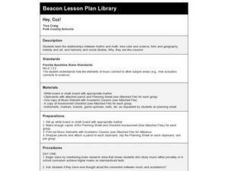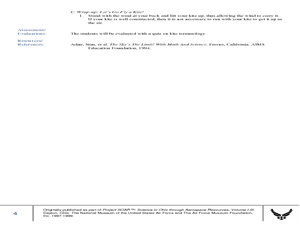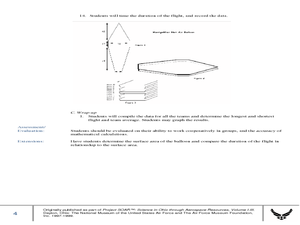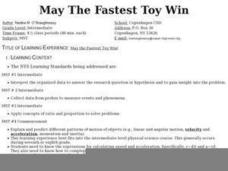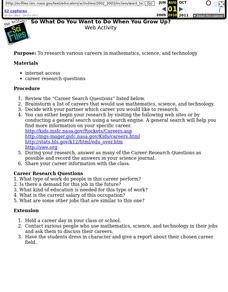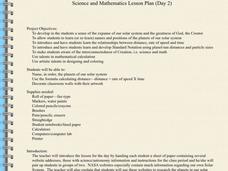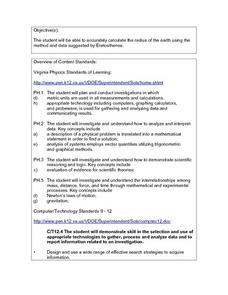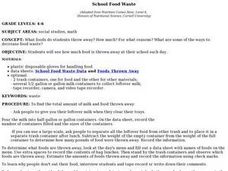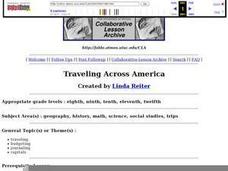Orange Public Schools
Stagecraft
The house lights dim, the curtain parts, lights slowly come up, revealing the stage. Before the actors appear, before a word is spoken, the audience is drawn in by the lighting, by the colors, by lines of the set, by the props, and...
Curated OER
Hey, Cuz!
Third graders examine the relationships between rhythm and math, tone color and science, form and geography, melody and art, and harmony and social studies. Why, they are like cousins! Students, in groups, present projects demonstrating...
Curated OER
The Paper Dutch Kite
Students construct a Dutch Kite using simple materials. In this math lesson, students measure kite dimensions according to specified instructions. They also describe and define the different parts of a kite.
Curated OER
Up, Up and Away with the Montgolfier Balloon
Students construct hot air balloons. In this science lesson, students assemble their own balloon using tissue paper and glue. They time the duration of the flight, record data and calculate team averages.
Curated OER
Trees for Tomorrow
Students examine how to plan for prudent use of trees so that we never run out of this natural resource. They determine what the oldest wooden object in their home is and draw picture of it. They observe a cross section of a tree and...
Curated OER
Fun with Balloons
Fifth graders design their own hot air balloon. In this science lesson, 5th graders investigate how factors like weight and sizes affect a balloon's lifting power. They also write math problems based on facts written in the...
Curated OER
Daily Survival Requirements of Water
Learners will use inquiry science to complete an investigation. They create hypotheses predicting the changes water undergoes in becoming ice and determine how much ice needs to be melted to create one 8 oz. glass of water.
Curated OER
Tree Search
Fifth graders plan and conduct investigations to identify and record tree species. They complete Forest Plotter and write about tree species found and draw pictures of them.
Curated OER
Wildlife, Wolves, Endangered Species
Learners use the Internet to research wildlife and conservation efforts. They examine pictures and graphics to research endangered species and humans role in their lives. They also use math to measure areas of habitats and add the number...
Curated OER
CSI Clamshell Investigation
Students explore predator/prey relationships. They research information on moon snails and claims. Students draw conclusions from the data collected. They use math and graphing to determine if there is a relationship to the clam's size...
Curated OER
Blowing in the Wind
Pupils compare hurricanes and tornadoes. They write a paragraph explaining how to prepare for a storm. Students give an oral report. They use weather facts to practice math skills. Pupils record observations of a storm.
Curated OER
May The Fastest Toy Win
Students determine which wind-up toy is the fastest. However, they can NOT race the toys. They must find another way. On the first day of the activity, students work in pairs or small groups to develop and write a plan.
Curated OER
Are You an Animal Safety Sleuth?
Students complete activities to investigate natural disasters and the impact on animals. In this natural disaster and animal safety instructional activity, students discuss the importance of safety procedures. Students use a map of their...
Curated OER
So What Do You Want to Do When You Grow Up
High schoolers research the responsibilities, required education, remuneration and demand for different of varied careers in math, science and technology. They access websites which are imbedded in this plan in order to do their research.
Curated OER
The Solar System
Young scholars research the characteristics of planets in our solar system. In this space science lesson, students create a solar system model with each planet arranged according to their distance from the sun. They solve problems using...
Curated OER
Watch It Slide!
Students work together to examine inclined planes. They create a plan to raise rocks to build pyramids. They discover the changes that occur when the angle is increased or decreased.
Curated OER
Out of This World and Into Our Classroom
Students complete a background survey on technology to determine where they need to focus on to complete this project. Using the Internet, they research a topic in Astronomy they are interested in and determine what math concepts are...
Curated OER
Lung Limit
Students determine their lung capacity by completing a science experiment with a bottle of water. In this lung science lesson, students discuss the lungs' purpose. Students complete an experiment to determine their lung capacity using a...
Curated OER
Looking into Eratosthenes' Radius of the Earth
Students, in small groups, research Eratosthenes and his calculations of the Earth's radius. They write a summary of the person, the experiments and his calculations to determine how accurate Eratosthenes was in his estimations of the...
Curated OER
School Food Waste
Students see how much food is thrown away at their school each day. They utilize a survey form imbedded in this plan to organize their research. They use the information gathered to make some suggestions about how to decrease food waste...
Curated OER
Traveling Across America
Students plan a trip to a state capital of their choice with a budget of $2,000. The budgets include site seeing, lodging, food and all necessary expenses. Students keep a daily journal and maintain their budget.
Curated OER
Where in the World?
Students explore how GPS works, the mathematics behind the technology, and how GPS is used. They find positions in one and two dimensions, and participate in a WebQuest that explores how math is used to find a location on Earth using GPS.
Curated OER
Size Per Unit
Fifth graders investigate how to find the average and the concept of a per unit quantity and its applications. They also make connections of using population density and how to find the speed with its relating formula. This is bringing...
Curated OER
Pea Brain! Explorations in Estimation
Students estimate how many peas fit in a container. In this science instructional activity, students calculate the weight of a pea and record it. They use this data to calculate how many peas fit in a human brain.

